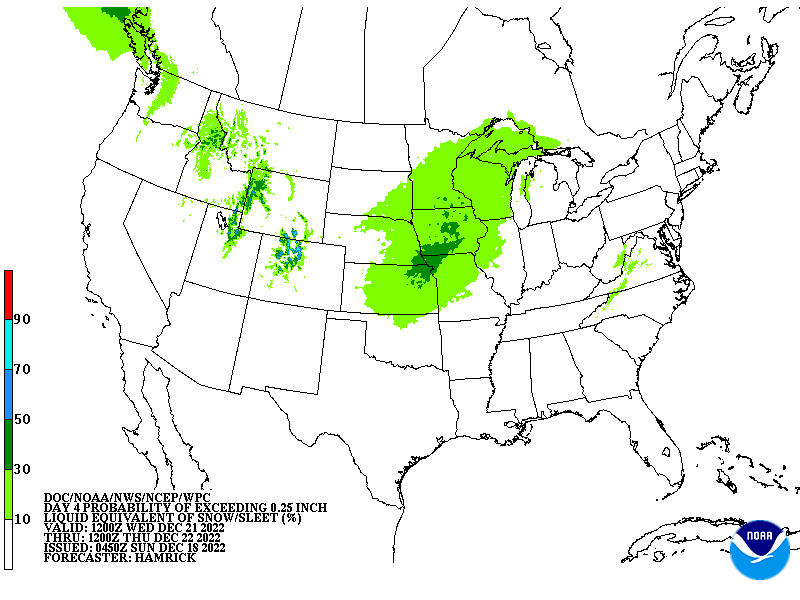| December 22 2022 |
Cross Country Major Winter Storm & Arctic Blast: (12/20 - 12/26)
By: David Hamrick, WPC Meteorologist
Meteorological Overview:
The 500mb pattern became highly amplified beginning on December 21st with a building ridge axis situated near the West Coast, and a deep upper trough from west-central Canada settled southward across the Northern Plains by 12Z on December 22nd as a piece of the polar vortex separated. This trough continued to become highly amplified with a closed low developing over the Upper Midwest, and the trough axis began acquiring negative tilt after 00Z on December 23rd across the Ohio Valley. A deep and anomalous upper low accompanied by incredibly strong 500mb winds on the order of 150 knots from Tennessee to the Mid-Atlantic, coupled with intense left-exit upper level jet dynamics, allowed for explosive surface cyclogenesis to occur. The central pressure of the surface low dropped from 1001 mb (00Z 23rd) to 970 mb (00Z 24th) in the course of just 24 hours, thus can be officially deemed a bomb cyclone. The low continued to deepen further with the lowest central pressure observed at 963 mb (12Z 24th) over central Quebec.
In addition to the severe winter storm, extreme cold enveloped much of the country east of the Rockies. An arctic air mass had been lingering over Montana and the Northern Plains for several days prior to the main event, but the cold front made a quick surge to the south beginning on December 21st across the Central Plains, and parts of the Denver metropolitan area had temperatures drop 25 degrees in just 5 five minutes! Cheyenne, WY recorded an impressive 32 degree drop in just nine minutes, and both Casper and Riverton set new all-time record lows at -42 and -31, respectively. Brutal wind chills also made weather headlines across all of the central and eastern U.S., especially across the Northern Rockies and the Dakotas, where wind chills on the order of -40 to -60 degrees were reported on the morning of December 22nd. An extreme report of -74 degrees was reported at the rural site of Elk Park, MT, where the actual air temperature was -49F.
This arctic boundary then reached the Texas Gulf Coast by the evening of the 22nd, crossing most of the East Coast by late morning on the 23rd, accompanied by widespread wind gusts in excess of 50 mph and impressive temperature drops on the order 15-30 degrees in just one hour. Even South Florida experienced this event with high temperatures struggling to reach 50 degrees for a high on Christmas Day, including Fort Lauderdale and Miami. This abrupt change was in stark contrast to the mild December that much of the southern U.S. had prior to this event. Numerous cities across the eastern U.S. from Florida to southern New England had record low maximum temperatures, with widespread highs in the teens across the northern Mid-Atlantic and the greater New York metropolitan area. Speaking of the Northeast U.S., a very strong southeasterly wind on the morning of the 23rd in the warm sector of the low produced significant coastal flooding across portions of Long Island and extending as far north as Maine, where storm warnings and even hurricane force wind warnings were in effect at the time.
The surge of frigid air across the Great Lakes resulted in a highly impactful lake effect snow event, especially downwind of Lake Erie in the greater Buffalo, NY metropolitan area, where it was described as a “once in a generation storm” producing more than 40 inches of snow along with wind gusts peaking at 79 mph, with 37 hours of blizzard conditions being reported at the Buffalo airport.
Impacts:
Numerous roads were closed and road travel was nearly impossible across this region, and travel bans were in effect. A total of 41 fatalities were attributed to the storm in Erie County, NY alone, and at least 100 fatalities in total across 17 states and the province of Ontario. These deaths were attributable to cold exposure outside, or inside homes without heat or inside disabled vehicles, traffic accidents, falling trees and large branches, electrocutions, and carbon monoxide poisonings.
Air travel was severely impacted by the wrath of this winter storm with more than 18,000 flights canceled in the United States between December 22nd and 28th, stranding hundreds of thousands of Christmas travelers. The Buffalo airport was closed from December 23-28 and it took multiple agencies and jurisdictions to clear the runways. Multiple Amtrak service routes also suspended train service across portions of the Midwest and Great Lakes region. Long portions of Interstates throughout the Dakotas and southern Minnesota were completely closed during the worst of the blizzard conditions. An estimated 6 million households in the U.S. lost power at some point during the storm and over 1 million in Canada, making the cold weather even more miserable.



